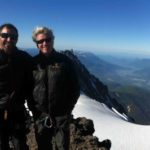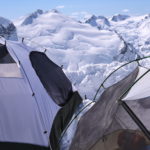Conditions Report | 12/27/2019
Winter Update | December 27th, 2019
Where that champagne powder at?
With Santa forgetting to deliver our usual meter of fresh champagne powder this Christmas, we've been experiencing some unique conditions this season. In case you missed out on our most recent newsletter (subscribe at the bottom right of this page!), we've included our most recent Conditions Report, according to our Lead Guide, below.
Snowpack:
There is about 1.5 to 2.5 meters of snow in the usual zones, more towards the coast and tapering quickly as you move east. Areas like Hanging Lake or Paul's Ridge have a healthy (deep) looking snowpack. The Duffy, on the other end, is still well below the threshold. What snow there is is generally skiing great - low density in most places but exposes ridge down and steep south facing slops
How to manage:
Look for terrain features that would collect snow, skiing parallel to ridge features, or finding areas of smoother ground cover (see avalanche issues) so a thin snowpack is still a nice smooth surface. The best skiing has been found at 1700 - 2000m.
Avalanche Issues:
The main issue this year is the Nov 23 Facet Layer, which if you have been watching the conditions lately has been the sliding layer of all the big natural and explosive controlled avalanches in the Spearhead Range. This layer is a thick, sugary (facet) layer very close to the ground surface; in most places it lies 30 - 100cm off the ground.
Basal (next to ground) Facet layers are quite common in our region; they form when we get an early snowfall in October or November followed by a cold dry period. Because there isn't much snow on the ground, there is a strong temperature gradient in the snow which causes it to facet out quickly. Normally by now we have been hit with a big moist storm, compressing this faceted layer, or at the least providing a thick enough layer of snow to form a bridge. This year, we are still waiting for this storm....
In the upper snowpack, there is a range of buried surface hoar layers that don't have enough load (settled new snow/slab) to be an issue yet. Something to check in on again once we get another snowfall.
How to manage:
Ground roughness - with the Nov 23 Layer being so close to the ground, we are mainly seeing avalanche on this layer in terrain where the ground cover is smooth. Where there is more surface roughness, this facet layer is not actually above threshold (30cm of facet, but lots of 60cm trees, rocks, undulations). Look for slopes that are broken up by lots of terrain features, avoiding terrain that is likely grass slopes, rock slopes or glacier.
Smaller slopes - With the slab over this layer being in the 1.5 - 2 meter range, you need a larger peice of terrain to get it moving. Stick to small terrain (less than size 2 features).
Avoid overhead hazard - Don't walk under big slopes! Chances are you are not as good at guessing how long a slide would run as you think you are. With deep instability such as this one, we just need to err on the side of caution.
Glaciers:
Last winter was a lean year in terms of snowpack depth and general density. The hot summer proceeded to recede and expose glacier ice in lots of areas, leaving glaciers more exposed and dry than "normal". This winter we need to take an extra layer of caution approaching glaciers as they are more broken and have a thinner snowpack covering crevasses.
As a rule of thumb, I like to see about 2.5 meters of well-settled snow on the glacier before I start skiing unroped (except in benign terrain). I don't suspect this will really present an issue to our general ski touring, we will just need a different approach to assessing conditions than in past years. [Plug Alert: TAKE A GLACIER TRAVEL/RESCUE COURSE!!]
How to manage:
Give it some time! Don't rush out to the usual glacier runs just yet. I would like to see another meter of settled snow before skiing lines like Spearhead Glacier, Decker or Anniversary Glacier. Small, planar lines might be possible with good evaluation.
Bring a rope! Seriously, buy a rescue kit and know how to use it. No matter the conditions, if you are skiing on a glacier with crevasses this should be standard.
Where to go backcountry skiing?
Yes, you can still find good, safe backcountry skiing!!!
Taking into consideration a lean snowpack, the Nov 23 Facet layer and thin glacier, our options are restricted but lots of good skiing exists. I have been skiing in the Callaghan area and Spearhead Range and have found great conditions, particularly focusing on tree skiing, lower angle alpine slopes, and small couloirs that don't run into steep fans.

Educate Yourself!
While some are fretting because conditions are abnormal in these parts, it's actually a great time to learn more about challenging snowpacks and glacier travel. The current challenging snowpack provides an opportunity to learn about facet layers, bridging stretch and critical terrain assessment.
AST 1 +
Every weekend!
$289
AST 2
Jan 2 - 5
Jan 13 - 16 *Based out of the new Spearhead hut*
Feb 6 - 9
Feb 21 - 24
Crevasse Rescue & Glacier Travel
Jan 6, 7
Jan 18, 19
Feb 8, 9
Feb 29, March 1





